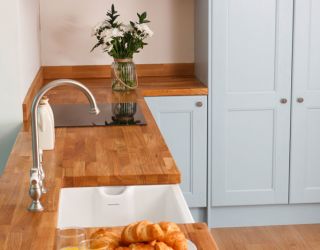How to Fix a Bowed or ‘Cupped’ Worktop: A Worktop Express® Nutshell Guide
Wood is a natural material and – like any product – if incorrectly handled it may be susceptible to damage. Our wood worktops are manufactured to the highest standard and we do everything that we can to ensure that the items reach you in perfect condition. However, in rare circumstances, problems can arise as a result of incorrect storage or installation.
Immediately after receipt, you should treat DIY worktops (worktops that have not been pre-oiled by ourselves) with two coats of Osmo Top Oil (the end grains will require three) in accordance with our maintenance guide. Once oiled, store your worktops indoors, away from any heated or damp areas, and lay flat with battens separating each worktop. If your worktop has become bowed, however, then panic not! The damage is far from irreversible; some very simple measures can be taken to restore it to its natural shape. First, let’s explain why your worktop may be like this, so that you may take the necessary preventative measures in future.
Not installing your worktops right away? Find out more about installation by reading this information guide:
Kiln Dried Worktops
- Our wooden worktops are kiln-dried to reduce the moisture content to 8 -10%; however, this may fluctuate due to the nature and structure of wood (which reacts to its environment).
- Wood expands and contracts with changes in the surrounding humidity and – to a lesser degree – temperature. More humid air will cause wood to expand and drier air will cause wood to contract.
Your worktops will acclimatise to the surrounding conditions and any changes in relative humidity and temperature may cause your kitchen worktop to warp. Worktops should be stored in the area of installation from the outset or, if stored in another area initially, should rest in the area of installation for at least 3 days before installation. Worktops transported from different surroundings and installed immediately are especially prone to movement and warping.

Bowing Once Installed
On rare occasions, timber worktops may bow once installed. Almost always this is a result of incorrect fitting, which restricts the wood’s natural contraction and expansion. The release of moisture in the room (from appliances such as tumble dryers) and insufficient protection may also cause damage.
- Begin the process by oiling your worktops with the recommended Osmo Top Oil (please see our guide to worktop maintenance for more information). This will seal the timber in preparation for installation. Ensure you apply at two coats (with 8-10 hours of drying time in between) to the faces, and three coats to the end grains.
- Fix the back end of the worktop to the supporting base units sitting beneath it. Make sure you’re only using the slotted angle brackets –any other fixing bracket will restrict the worktop’s natural movement. Use the slot that runs perpendicular to the direction of the grain pattern (across, not parallel with it).
- Slowly and gently pull the worktop down using clamps and battens. It’s important not to rush this stage – the timber will split if you use too much force – and be patient: this part of the process can take 1-2 weeks.
- Once the worktop has been pulled down, secure the front edge, too. Your worktop should be back to its natural shape now.
If your worktop is warped rather than bowed or cupped, you’ll want to read how to correct it by visiting the following information guide:
Fixing a bowed worktop that has already been installed
Once installed cupping or warping can occasionally occur as a result of the wood reacting to changes in relative humidity or temperature. For example, if the top (as it is more exposed to the environment) reacts more swiftly than the bottom (which is often more sheltered), the wood “cups”. Furthermore, if your worktop has been installed incorrectly – if you have used the wrong slotted brackets, for example, or if the timber does not have sufficient protection – it can bow during its use.
If your worktop has cupped upwards: this may be fixed quite easily by placing a reasonable (but not excessive) weight on the bowed area, causing it to gently return to its natural flat shape.
If your worktop has cupped downwards: this may be fixed quite easily by placing a reasonable (but not excessive) weight on the bowed area, causing it to gently return to its natural flat shape.

Furthermore, an overhang of more than 200mm should not be left unsupported. In some circumstances, the only method for fixing a cupped worktop would be to uninstall the worktop and re-install it according to the approved instructions above.
And finally… Upon (re)installation of your worktop, make sure you have provided the correct protection: moisture barriers fitted above relevant appliances will prevent changes in humidity from affecting your worktop, and sufficient oiling to the underside of your worktop will also reduce potential damage, too. You should leave at least a 30mm gap between the end cap and a heat source such as an AGA or freestanding oven to protect the end grain from exposure to excessive heat.
If your worktops have been damaged in any other way, we recommend referring to:

 65,000+ Reviews | 4.8 TrustScore
65,000+ Reviews | 4.8 TrustScore